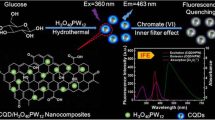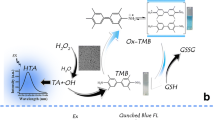Abstract
Carbon dots doped with copper(II) and nitrogen (Cu,N@C-dots) were prepared and are shown to be viable fluorescent nanoprobe for pyrogallol (PGL) was developed for the first time. The reaction is based on (a) the complexation reaction between Cu,N@C-dots and catechol moiety, and (b) the generation of a quinone-like structure. Thus, the co-ordination complex formed between Cu(II) in C-dots and PGL results in quenching of the fluorescence of C-dots. In addition, the formation of a yellow color due to complex formation between the nanoprobe and Cu(II) allowed the colorimetric determination of PGL. The nanoprobe was prepared by thermal synthesis, using ethylenediaminetetraacetic acid salt and copper(II) chloride as sources for carbon, nitrogen and copper, respectively. The carbon dots were characterized by UV-VIS spectroscopy, Fourier transform infrared spectroscopy, powder X-ray diffraction, transmission electron microscopy) and dynamic light scattering. Fluorescence drops linearly in the 0.15 to 70 μM PGL concentration range with a detection limit of 39 nM and a relative standard deviation of 1.8%. The optimal excitation and emission wavelengths are 370 nm and 428 nm, respectively. The colorimetric assay has a linear response at 325 nm absorption wavelengths in the 6 to 140 μM PGL concentration range with a detection limit of 1.8 μM and a 2.3% relative standard deviation.

Dual mode colorimetric and fluorimetric nanoprobe was designated for pyrolgallol determination based on complexation with copper(II)- and nitrogen-doped carbon dots.








Similar content being viewed by others
References
Budavari S O’Neil MJI, Whitehouse Station NJ (1996) In: The Merck Index, 13th Edn., Merck & Co. 948
Sharma M, Rai K, Sharma SS, Gupta YK (2000) Effect of antioxidants on pyrogallol-induced delay in gastric emptying in rats. Pharmacology 60:90–96. https://doi.org/10.1159/000028352
Upadhyay G, Kumar A, Singh MP (2007) Effect of silymarin on pyrogallol-and rifampicin-induced hepatotoxicity in mouse. Eur J Pharmacol 565:190–201. https://doi.org/10.1016/j.ejphar.2007.03.004)
Inui T, Nakahara K, Uchida M, Miki W, Unoura K, Kokeguchi Y (2004) Oxidation of ethanol induced by simple polyphenols: Prooxidant property of polyphenols. Bull Chem Soc Jpn 77:1201–1207. https://doi.org/10.1246/bcsj.77.1201
Joharapurkar A, Wanjari M, Dixit P, Zambad S, Umathe S (2004) Pyrogallol: a novel tool for screening immunomodulators. Indian journal of pharmacology 36:355
Mudasir M, Mugiyanti M, Hadipranoto N (2010) Spectrophotometric determination of pyrocathecol and pyrogallol based on their redox reaction with iron (III)/phenanthroline system. Indonesian Journal of Chemistry 2:161–166
Zhongliang Z, Guohua Z, Tonghua L (1996) Simultaneous Determination of Mixtures of Homologue of Phenol by pH-Titration and Principal Component Regression Chinese Journal of Analytical Chemistry 1:87-89
Ortega F, Dominguez E, Jönsson-Pettersson G, Gorton L (1993) Amperometric biosensor for the determination of phenolic compounds using a tyrosinase graphite electrode in a flow injection system. Journal of bio technology 31:289–300. https://doi.org/10.1016/0168-1656(93)90075-X
Coquart V, Hennion MC (1992) Trace-level determination of polar phenolic compounds in aqueous samples by high-performance liquid chromatography and on-line preconcentration on porous graphitic carbon. J Chromatogr A 600:195–201. https://doi.org/10.1016/0021-9673(92)85548-8
Achilli G, Cellerino GP, d'Eril GM (1995) Simultaneous determination of 27 phenols and herbicides in water by high-performance liquid chromatography with multielectrode electrochemical detection. J Chromatogr A 697:357–362
Tor ER, Francis TM, Holstege DM, Galey FD (1996) GC/MS determination of pyrogallol and gallic acid in biological matrices as diagnostic indicators of oak exposure. J Agric Food Chem 44:1275–1279. https://doi.org/10.1021/jf950238k
Chen J, Bai J (2008) Chemiluminescence flow sensor with immobilized reagent for the determination of pyrogallol based on potassium hexacyanoferrate (III) oxidation. Molecular and Biomolecular Spectroscopy 71:989–992. https://doi.org/10.1016/j.saa.2008.02.022
Mitchell CA (1924) Osmium tetroxide as a reagent for the estimation of tannins and their derivatives. Analyst 49:162–169. https://doi.org/10.1016/0021-9673(94)00791-7
Usmani Q, Beg M, Shukla IC (1979) Spectrophotometric determination of microgram amounts of hydroquinone, pyrogallol and resorcinol. Analyst 104:148–151
Gazaryan I, Loginov D, Lialulin A, Shekhovtsova TJ (1994) Determination of phenols using various peroxidases. Anal Lett 27:2917–2930. https://doi.org/10.1080/00032719408000301
Shamsipur M, Molaei K, Molaabasi F, Alipour M, Alizadeh N, Hosseinkhani S, Hosseini M (2018) Facile preparation and characterization of new green emitting carbon dots for sensitive and selective off/on detection of Fe3+ ion and ascorbic acid in water and urine samples and intracellular imaging in living cells. Talanta 183:122–130. https://doi.org/10.1016/j.talanta.2018.02.042
Shamsipur M, Molaei K, Molaabasi F, Hosseinkhani S, Alizadeh N, Alipour M, Moassess S (2018) One-step synthesis and characterization of highly luminescent nitrogen and phosphorus co-doped carbon dots and their application as highly selective and sensitive nanoprobes for low level detection of uranyl ion in hair and water samples and application to cellular imaging. Sensors Actuators B Chem 257:772–782. https://doi.org/10.1016/j.snb.2017.11.018
Xu Y, Wu M, Liu Y, Feng XZ, Yin XB, He XW, Zhang YK (2013) Nitrogen-doped carbon dots: a facile and general preparation method, photoluminescence investigation, and imaging applications. Chem Eur J 19:2276–2283. https://doi.org/10.1002/chem.201203641
Mahmoud AM, El-Wekil MM, Mahnashi MH, Ali MF, Alkahtani SA (2019) Modification of N, S co-doped graphene quantum dots with p-aminothiophenol-functionalized gold nanoparticles for molecular imprint-based voltammetric determination of the antiviral drug sofosbuvir. Microchemica Acta 186:617. https://doi.org/10.1007/s00604-019-3647-7
Wu W, Zhan L, Fan W, Song J, Li X, Li Z, Wang R, Zhang J, Zheng JW (2015) Cu–N dopants boost electron transfer and photooxidation reactions of carbon dots. Angew Chem 54:6540–6544. https://doi.org/10.1002/anie.201501912
Mongay C, Cerda V (1974) Britton–Robinson buffer of known ionic strength. Anal Chem 64:409–412
Lin J-M, Yamada M (1999) Oxidation reaction between periodate and polyhydroxyl compounds and its application to chemiluminescence. Analytical C hemistry 71:1760–1766. https://doi.org/10.1021/ac981341m
Yang Y, Cui J, Zheng M, Hu C, Tan S, Xiao Y, Yang Q, Liu Y (2012) One-step synthesis of amino-functionalized fluorescent carbon nanoparticles by hydrothermal carbonization of chitosan. Chemical Communication 48:380–382
Mehta VN, Jha S, Basu H, Singhal RK, Kailasa SK (2015) One-step hydrothermal approach to fabricate carbon dots from apple juice for imaging of mycobacterium and fungal cells. Sensors Actuators B Chem 213:434–443. https://doi.org/10.1016/j.snb.2015.02.104
Das P, Ganguly S, Mondal S, Bose M, Das AK, Banerjee S, Das NC (2018) Heteroatom doped photoluminescent carbon dots for sensitive detection of acetone in human fluids. Sensors Actuators B Chem 266:583–593. https://doi.org/10.1016/j.snb.2018.03.183
De B, Karak N (2013) A green and facile approach for the synthesis of water soluble fluorescent carbon dots from banana juice. RSC Adv 3:8286–8290
Williams ATR, Winfield SA, Miller JN (1983) Relative fluorescence quantum yields using a computer-controlled luminescence spectrometer. Analyst 108:1067–1071
Green NJ, Pimblott SM, Tachiya MJ (1993) Generalizations of the stern-Volmer relation. J Phys Chem 97:196–202. https://doi.org/10.1021/j100103a034
da Silva Padilha CV, Miskinis GA, de Souza MEAO, Pereira GE, de Oliveira D, Bordignon-Luiz MT, dos Santos Lima M (2017) Rapid determination of flavonoids and phenolic acids in grape juices and wines by RP-HPLC/DAD: method validation and characterization of commercial products of the new Brazilian varieties of grape. Food Chem 228:106–115. https://doi.org/10.1016/j.foodchem.2017.01.137
Arce L, Ríos A, Valcarcel MJ (1998) Determination of anti-carcinogenic polyphenols present in green tea using capillary electrophoresis coupled to a flow injection system. J Chromatogr A 827:113–120. https://doi.org/10.1016/S0021-9673(98)00737-7
Shah SNA, Li H, Lin J-M (2016) Enhancement of periodate-hydrogen peroxide chemiluminescence by nitrogen doped carbon dots and its application for the determination of pyrogallol and gallic acid. Talanta 153:23–30. https://doi.org/10.1016/j.talanta.2016.02.056
Hu G, Chen P, Wang W, Hu L, Song J, Qiu L, Song J (2007) Kinetic determination of pyrogallol by a novel oscillating chemical reaction catalyzed by a tetraazamacrocyclic complex. Electrocheica acta 52:7996–8002. https://doi.org/10.1016/j.electacta.2007.06.067
Zhao C, Song J, Zhang J (2003) Flow-injection biamperometry of pyrogallol compounds. Talanta 59:19–26. https://doi.org/10.1016/S0039-9140(02)00459-9
Author information
Authors and Affiliations
Corresponding author
Additional information
Publisher’s note
Springer Nature remains neutral with regard to jurisdictional claims in published maps and institutional affiliations.
Electronic supplementary material
ESM 1
(DOC 11529 kb)
Rights and permissions
About this article
Cite this article
Ali, H.R.H., Hassan, A.I., Hassan, Y.F. et al. Colorimetric and fluorimetric (dual-mode) nanoprobe for the determination of pyrogallol based on the complexation with copper(II)- and nitrogen-doped carbon dots. Microchim Acta 186, 850 (2019). https://doi.org/10.1007/s00604-019-3892-9
Received:
Accepted:
Published:
DOI: https://doi.org/10.1007/s00604-019-3892-9




